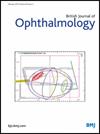Photoreceptor layer thickness in age-related macular degeneration: the Beijing Eye Study
IF 3.5
2区 医学
Q1 OPHTHALMOLOGY
引用次数: 0
Abstract
Purpose To assess the photoreceptor layer thickness and its associations with age-related macular degeneration (AMD). Methods Participants of the population-based Beijing Eye Study without optic nerve or retinal diseases (except for early and intermediate AMD) were examined by optical coherence tomography of the macula. Results The study cohort was composed of 2426 participants (mean age: 62.8±9.1 years; range: 50–93 years), with 200 and 393 individuals affected by early AMD and intermediate AMD, respectively. In multivariable analysis, thickness of Henle’s fibre layer, outer nuclear layer, external limiting membrane and myoid zone (HOEM) combined was not significantly associated with AMD prevalence (beta: 0.03; p=0.08) or AMD stage (beta: 0.04; p=0.06), after adjusting for younger age (beta: −0.09; p<0.001), shorter axial length (beta: −0.07; p<0.001), thicker ellipsoid zone (EZ) (beta: 0.19; p<0.001), thicker photoreceptor outer segment (POS) layer (beta: 0.12; p<0.001), thicker subfoveal choroid (beta: 0.11; p<0.001) and thinner retinal pigment epithelium/Bruch’s membrane (RPE/BM) layer (beta: −0.17; p<0.001). Thicker EZ correlated with lower AMD prevalence (beta: −0.04; p=0.03) and lower AMD stage (beta: −0.02; p=0.02), with adjustment for older age (beta: 0.05; p=0.03), longer axial length (beta: 0.06; p=0.001), thicker HOEM (beta: 0.19; p<0.001) and thinner RPE/BM (beta: −0.31; p<0.001). Including only normal eyes and eyes with early AMD, EZ thickness was not significantly correlated with AMD prevalence (beta: −0.02; p=0.49). Thicker POS correlated with lower AMD prevalence (beta: −0.06; p<0.001) after adjusting for younger age (beta: −0.10; p<0.001), thicker HOEM (beta: 0.08; p<0.001) and thinner RPE/BM layer (beta: −0.62; p<0.001). If only normal eyes and eyes with early AMD were included, POS thickness was not significantly related to AMD prevalence (beta: −0.03; p=0.09). Conclusions Thickness of HOEM, EZ and POS was not significantly associated with the prevalence of early AMD. Data are available upon reasonable request.年龄相关性黄斑变性的光感受器层厚度:北京眼研究
目的探讨光感受器层厚度与老年性黄斑变性(AMD)的关系。方法对北京眼科研究人群中无视神经或视网膜疾病(早期和中期AMD除外)的参与者进行黄斑光学相干断层扫描检查。结果研究队列由2426名参与者组成(平均年龄:62.8±9.1岁;范围:50-93岁),其中早期AMD和中期AMD患者分别为200例和393例。在多变量分析中,经调整年龄(β: - 0.09, p<0.001)、轴向长度较短(β: - 0.07, p<0.001)、椭球区(EZ)较厚(β: 0.19, p<0.001)、光感受器外段(POS)层较厚(β: 0.12, p<0.001)和AMD分期(β: 0.04, p=0.06)后,Henle纤维层、外核层、外限制膜和肌样带(HOEM)的厚度组合与AMD患病率(β: 0.03, p=0.08)或AMD分期(β: 0.04, p=0.06)无显著相关性。p<0.001),更厚的中央凹下脉络膜(β: 0.11, p<0.001)和更薄的视网膜色素上皮/Bruch膜(RPE/BM)层(β:−0.17,p<0.001)。较厚的EZ与较低的AMD患病率(β:−0.04,p=0.03)和较低的AMD分期(β:−0.02,p=0.02)相关,调整年龄(β: 0.05, p=0.03)、较长的轴长(β: 0.06, p=0.001)、较厚的HOEM (β: 0.19, p<0.001)和较薄的RPE/BM (β:−0.31,p<0.001)。仅包括正常眼和早期AMD眼,EZ厚度与AMD患病率无显著相关性(β:−0.02;p=0.49)。在调整年龄(β:−0.10,p<0.001)、HOEM (β: 0.08, p<0.001)和RPE/BM层(β:−0.62,p<0.001)后,较厚的POS与较低的AMD患病率相关(β:−0.06,p<0.001)。如果只包括正常眼睛和早期AMD的眼睛,POS厚度与AMD患病率无显著相关性(β:−0.03;p=0.09)。结论HOEM、EZ、POS厚度与早期AMD患病率无显著相关性。如有合理要求,可提供资料。
本文章由计算机程序翻译,如有差异,请以英文原文为准。
求助全文
约1分钟内获得全文
求助全文
来源期刊
CiteScore
10.30
自引率
2.40%
发文量
213
审稿时长
3-6 weeks
期刊介绍:
The British Journal of Ophthalmology (BJO) is an international peer-reviewed journal for ophthalmologists and visual science specialists. BJO publishes clinical investigations, clinical observations, and clinically relevant laboratory investigations related to ophthalmology. It also provides major reviews and also publishes manuscripts covering regional issues in a global context.

 求助内容:
求助内容: 应助结果提醒方式:
应助结果提醒方式:


